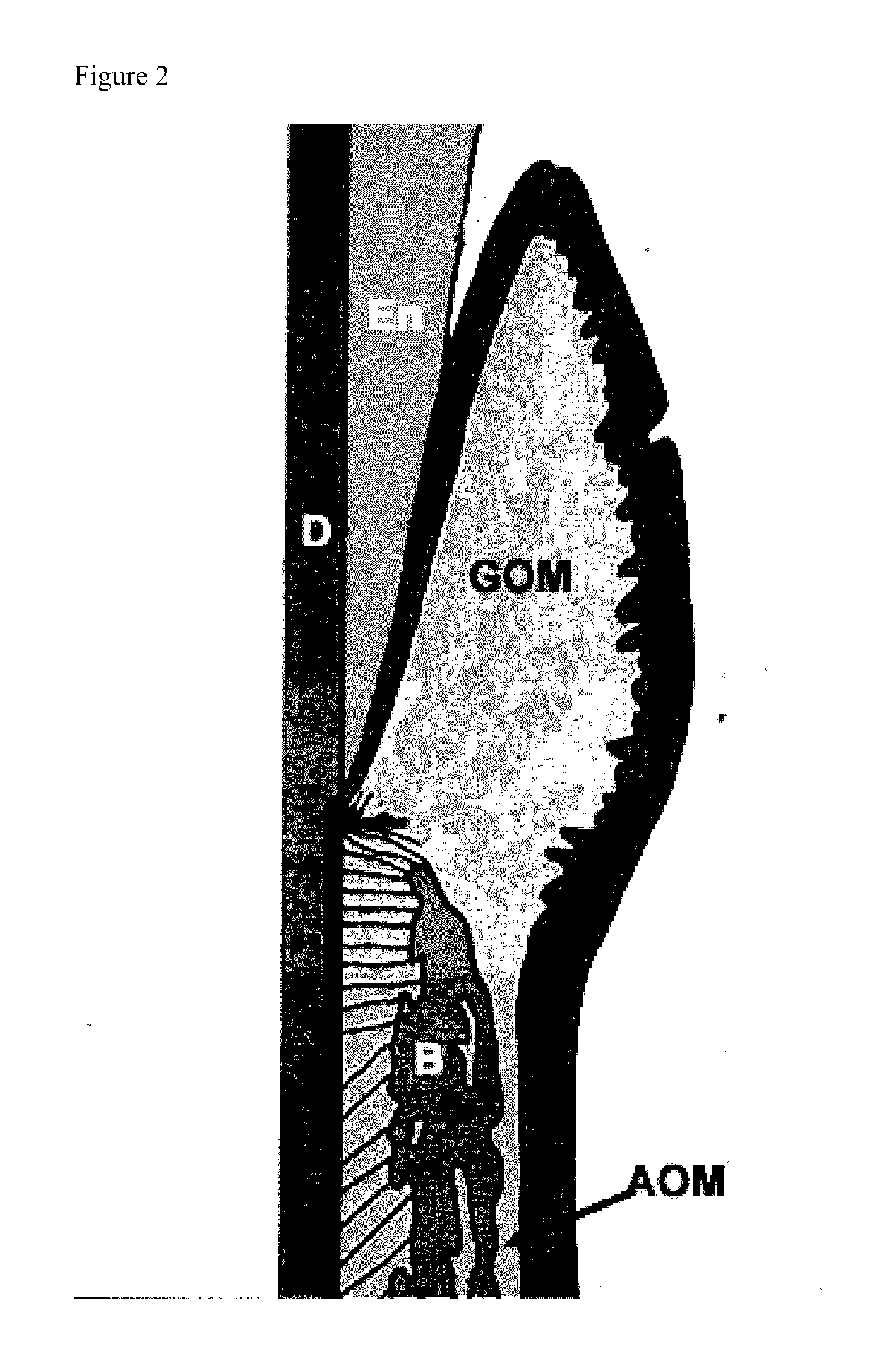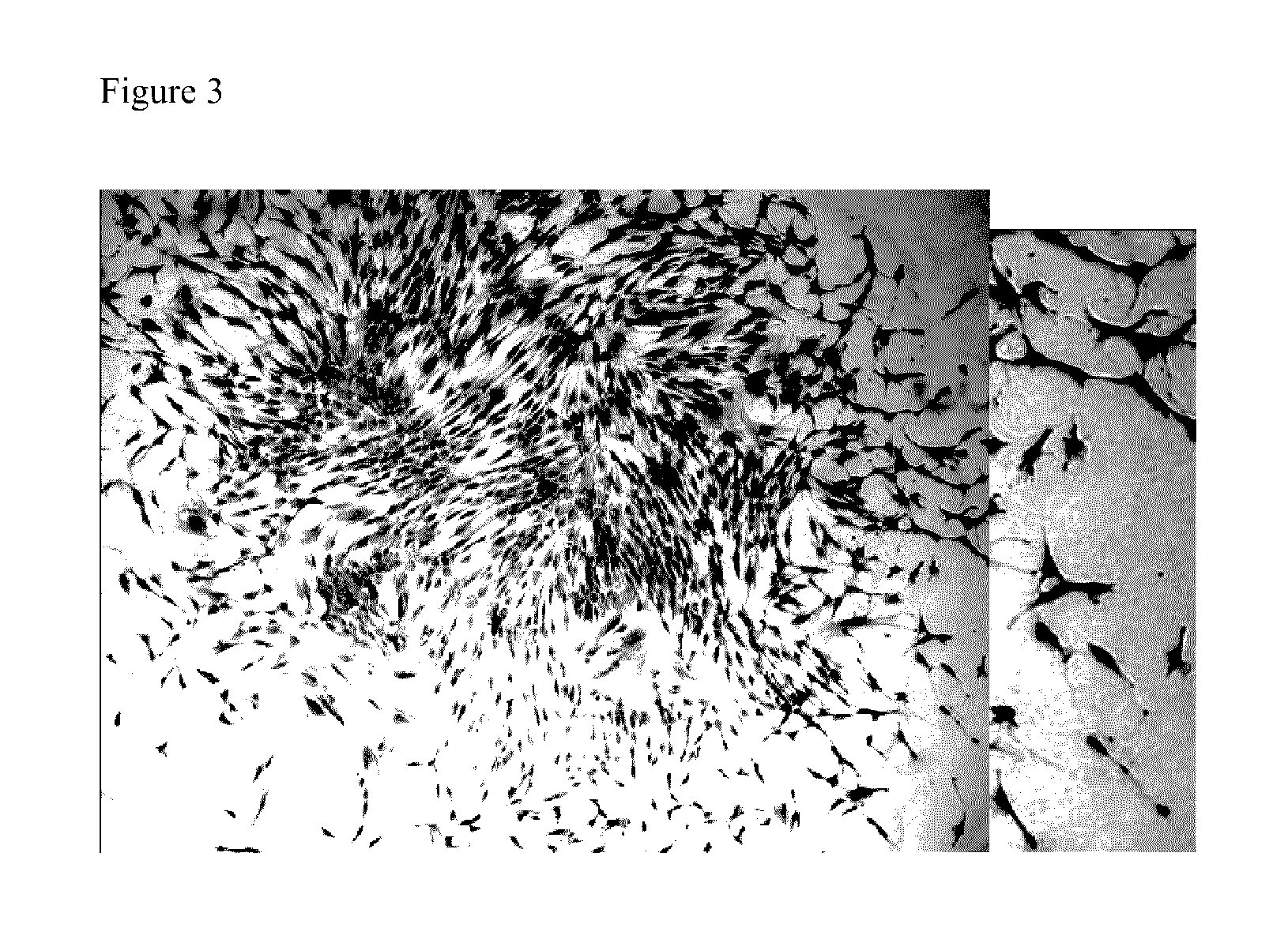Culture of pluripotent autologous stem cells from oral mucosa
a technology of autologous stem cells and oral mucosa, which is applied in the field of stem cells, can solve the problems of insufficient grafting or graft versus host disease, serious doubts whether in vivo recruitment of endogenous stem cells may be realistic clinical prospects, and aging and disease substantially lower the functionality and possibly the availability of adult stem cells in bone marrow and other tissues
- Summary
- Abstract
- Description
- Claims
- Application Information
AI Technical Summary
Benefits of technology
Problems solved by technology
Method used
Image
Examples
example 1
Clonogenicity Determination
[0209]A common method in the art to assess the size of a potential stem cell population in a tissue is to test the number of one cell-derived growing clones that can be derived in vitro from a population of cells obtained from the specific tissue. To assess the general frequency of clonogenic cells in primary oral mucosa cell cultures (OMC), cells were plated at a cloning density of one cell / cm2 and the colony forming unit-fibroblast (CFU-F) was determined. The colony-forming efficiency (CFE) namely the incidence of clonogenic cells capable of forming colonies comprising more than 100 cells, was eight percent. This is a substantially higher value (2-10 folds) compared to previously published values for bone marrow and other connective tissues-derived MSC (Reyes M et al., Blood 96:2615-2625, 2001; D'Ippolito G et al., Rejuvenation Research 9:10-18, 2006). The cells of these colonies are small with low cytoplasm / nucleus ratio as demonstrated in FIG. 3. Inter...
example 2
Determination of OMC Multipotency
[0210]To determine multiplicity, the size and potency of a whole population to differentiate into various cell lines of various tissues, is checked. The higher the proportion of stem cells in the population the higher the propensity of this whole population to differentiate into a larger number of cell lines. In a such an experiment it was found that in contradistinction to other whole non-bone marrow derived-mesenchymal populations (e.g. dermal fibroblasts), the OMC-primary whole population from the lamina propria of gingival oral mucosa, differentiated into osteoblastic, chondroblastic and adipocytic lineages as demonstrated by: i. Alizarin red staining of mineralized-like tissue (left panel), ii. Alcian blue staining of proteoglycans demonstrating chondroblastic differentiation of micromas (middle panel), and iii. oil red staining of triglyceride droplets representing adypogeic differentiation (FIG. 6, right panel). The results prove that the very...
example 3
Determination of Cell's Pluripotency
[0224]Pluripotency refer to the capacity of a cell population to differentiate to any cell lineage of the adult organism. This property is usually attributed to the embryonic stem cells (ESC). ESC are characterized by a number of surface markers such as: SSEA3, SSEA4, Tra-1-61, Tra-1-81, Tra-2-49, Tra-2-54 and nuclear markers such as POU5F1 / Oct-4, Nanog, Sox 2 and a few other markers.
[0225]The expression of some of these markers at the protein and message level were assessed in whole cultures obtained from several donors. The expression at the protein level was assessed by flow cytometry (FACS) and by indirect immunofluorescence. At the message level the expression was assessed by RT-PCR.
[0226]The results are summarized in Table 1 and illustrated in FIGS. 7-9. FIG. 7 demonstrates examples of FACS analysis of the pluripotent markers Oct4 (A) and SSEA4 (B) expressed in a whole unsorted population of a culture obtained from the lamina propria of oral...
PUM
| Property | Measurement | Unit |
|---|---|---|
| doubling time | aaaaa | aaaaa |
| pH | aaaaa | aaaaa |
| density | aaaaa | aaaaa |
Abstract
Description
Claims
Application Information
 Login to View More
Login to View More - R&D
- Intellectual Property
- Life Sciences
- Materials
- Tech Scout
- Unparalleled Data Quality
- Higher Quality Content
- 60% Fewer Hallucinations
Browse by: Latest US Patents, China's latest patents, Technical Efficacy Thesaurus, Application Domain, Technology Topic, Popular Technical Reports.
© 2025 PatSnap. All rights reserved.Legal|Privacy policy|Modern Slavery Act Transparency Statement|Sitemap|About US| Contact US: help@patsnap.com



